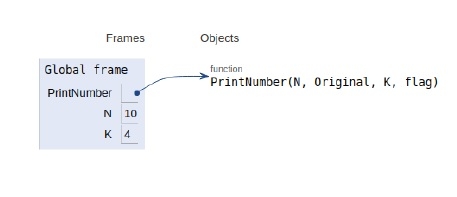
 Data Structure
Data Structure Networking
Networking RDBMS
RDBMS Operating System
Operating System Java
Java MS Excel
MS Excel iOS
iOS HTML
HTML CSS
CSS Android
Android Python
Python C Programming
C Programming C++
C++ C#
C# MongoDB
MongoDB MySQL
MySQL Javascript
Javascript PHP
PHP
- Selected Reading
- UPSC IAS Exams Notes
- Developer's Best Practices
- Questions and Answers
- Effective Resume Writing
- HR Interview Questions
- Computer Glossary
- Who is Who
Python Program for Print Number series without using any loop
In this article, we will learn about the solution to the problem statement given below −
Problem statement − Given Two number N and K, our problem is to subtract a number K from N until number(N) is greater than zero(0), once the N becomes negative or zero then we start adding K to it until that number become the original number(N).
For example,
N = 10 K = 4 Output will be: 10 6 2 -2 2 6 10
Algorithm
1. we call the function again and again until N is greater than zero (in every function call we subtract K from N ). 2. Once the number becomes negative or zero we start adding K in each function call until the number becomes the original number. 3. Here we used a single function for purpose of addition and subtraction but to switch between addition or subtraction function we used a Boolean type variable flag.
Now let’s observe the implementation in Python
Example
def PrintNumber(N, Original, K, flag): #print the number print(N, end = " ") #if number become negative if (N <= 0): if(flag==0): flag = 1 else: flag = 0 if (N == Original and (not(flag))): return # if flag is true if (flag == True): PrintNumber(N - K, Original, K, flag) return if (not(flag)): PrintNumber(N + K, Original, K, flag); return N = 10 K = 4 PrintNumber(N, N, K, True)
Output
10 6 2 -2 2 6 10
Here all variables are declared in global namespace as shown in the image below −

Conclusion
In this article, we learned about the terminology for printing a number series without using any kind of looping construct in Python 3.x. Or earlier.

Advertisements